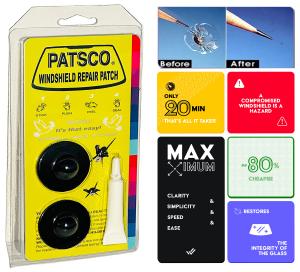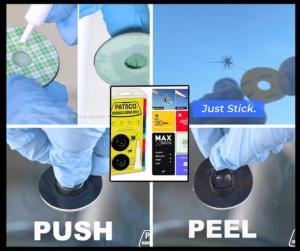
DIY Windshield Repair Kits vs. Patsco Windshield Repair Patch
Conventional do-it-yourself (DIY) windshield repair kits that rely on injectors and drilling, and a more recent approach exemplified by the Patsco Patch.
Background and Market Overview
Minor windshield damage is a common concern for motorists. Rock chips, bullseyes, star cracks, and half-moon fractures often result from pebbles or other debris striking the windshield. In many cases, such blemishes remain stable for a time but can spread due to factors such as thermal expansion, road vibrations, or moisture intrusion. Windshield replacement is traditionally recommended when damage extends beyond a few inches or compromises visibility in the driver’s line of sight. However, do-it-yourself repair kits and patch-based solutions offer an alternative for smaller defects, potentially delaying the need for a full windshield replacement.
The DIY market for windshield repair first took shape several decades ago, when at-home resin injector kits were introduced. These products aimed to mimic elements of professional repair procedures that use specialized vacuum systems, cured resin, and drilling techniques to reinforce damaged glass. As this sector matured, innovations appeared in resin formulas and application tools. Patented products, such as the Patsco Windshield Repair Patch, emerged to simplify certain aspects of the process by removing the need for drills or injectors.
Traditional DIY Windshield Repair Kits (Injector-Based)
Injector-based kits typically include a syringe or plunger-style applicator, resin, adhesive seals or suction devices, curing strips, and a small razor blade. The process often requires multiple steps to ensure a proper seal around the damage. The resin, which is usually designed to harden under ultraviolet light, must be introduced into the chip or crack through a controlled injection. This involves attaching the applicator directly over the damaged region and using either pressure or a vacuum system to guide the resin into fine fissures.
In some kits, drilling a shallow hole into the outer glass layer is advised to facilitate resin flow. This procedure can be intimidating for those without prior experience in automotive maintenance, though manufacturers generally supply detailed instructions. Curing time depends on the type of resin and the light conditions, which may range from direct sunlight to artificial UV lamps. Once the resin sets, excess material is scraped away, leaving a glass-like finish designed to reduce the visibility of the chip.
Advantages of these kits typically include a capacity for thorough resin penetration into deeper cracks, consistent results when applied correctly, and a level of familiarity within automotive circles. Certain industry observers note that injector-based systems often trace their lineage to professional repair technology, which can be beneficial for complex chips. Potential drawbacks involve the time required for setup, the possibility of incomplete resin distribution if air bubbles remain, and the learning curve associated with aligning and operating injectors. Some users also report challenges when balancing vacuum and pressure cycles needed to remove trapped air.
Patsco Windshield Repair Patch (Patent No. US 10,946,624)
The Patsco Windshield Repair Patch introduces a patented method of distributing resin without drills or injectors. According to publicly available information, the patch was devised to simplify windshield repair for those seeking fewer steps and minimal equipment. The kit commonly contains two adhesive patches, liquid resin, a razor for removing excess material, small pieces of tape for alignment, and additional guide materials. The package design focuses on portability, suggesting that the patch can be stored for on-the-spot use when a chip is first noticed.
The company behind this solution states that cracks up to the size of a half dollar can be addressed, although deeper or more extensive damage may require professional evaluation. A key feature involves placing resin within the patch, pressing it against the chipped or cracked area, and allowing the resin to settle. After an interval that is often cited as approximately 20 minutes, the patch can be peeled away, then seal it. The absence of drilling or injector pressure reduces concerns about introducing additional fractures during the repair. The method is generally positioned as a more streamlined and user-friendly approach.
Observers within the automotive maintenance field note that this patch-based technology may facilitate swift interventions, potentially preventing contaminants from infiltrating the crack. The patch’s peel-and-stick format reduces the steps involved in managing suction cups or injector placements. Although it is described as improving clarity, actual visibility gains can vary based on the shape and type of chip.
Key Product Details
Patsco Windshield Repair Patch:
Patent No. US 10,946,624
Repairs cracks up to the size of a half dollar
No need for drills or injectors
Typically involves a peel-and-stick procedure for resin application
Includes adhesive patches, liquid resin, tape, and a razor
Typical DIY Injector Kits:
Often rely on a syringe or plunger for resin injection
May recommend shallow drilling for improved resin flow
Require a period of UV-based curing
Often effective for small to moderate chips if the resin is properly injected
Can demand multiple steps to remove air bubbles thoroughly
Comparison of Results
Both methods share a goal of stabilizing minor windshield damage and reducing the chance of crack expansion. They also strive to restore partial or significant clarity, although the outcome varies based on multiple factors. Injector-based kits rely on forced resin injection to access deeper segments of the crack, which can promote a more comprehensive seal if the technique is executed correctly. Patch-based methods aim to seal the surface without drilling, resulting in a more straightforward process that may reduce the risk of additional breakage at the point of impact.
Patrick McClain
Patsco LLC
+1 832-454-8163
email us here
Visit us on social media:
Facebook
X
LinkedIn
Instagram
TikTok
Distribution channels: Automotive Industry, Consumer Goods, Insurance Industry, Military Industry, Shipping, Storage & Logistics
Legal Disclaimer:
EIN Presswire provides this news content "as is" without warranty of any kind. We do not accept any responsibility or liability for the accuracy, content, images, videos, licenses, completeness, legality, or reliability of the information contained in this article. If you have any complaints or copyright issues related to this article, kindly contact the author above.
Submit your press release


